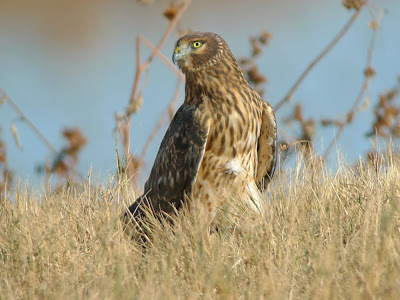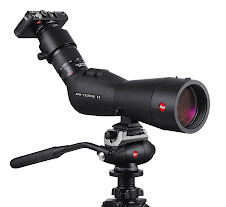
One of the big questions spotting scope consumers have to answer is, "which size scope should I buy?" Like most manufacturers, Leica offers two different scope sizes: a larger 82 mm model (bottom) and a more compact 65 mm model (at top). The mm listing is the physical diameter of the objective lens which is opposite the smaller eyepiece. A larger objective lens allows more light to enter the optical system, meaning there is a larger circle of light entering your eye (or camera if digiscoping).
Consumers have to balance absolute optical performance with portability, and ease of use in the same way they do with binoculars. Obviously, this is a very personal decision and one that each individual has to make for themselves. To answer this fully one has to consider their individual habits to include: 'will I be using the scope at last light or first light or in very dark conditions?' (tropical rain forests for example), and 'will I tend to not carry a heavier scope?' I suspect the latter question is most important actually because if the size and weight will preclude or dissuade you from using the scope then clearly the more compact, lightweight option is for you!

left to right Kenn Kaufman, Bill Thompson, III, and Pete Dunne at Asa Wright Nature Centre
Along that line, while I certainly feel the APO Televid 82 mm represents the pinnacle of optical performance, I would never discourage anyone from looking toward the smaller APO Televid 65 mm spotting scope either. I think it is superb and it definitely outperforms its predecessor and rivals the performance of our older 77 mm models. Naturally, being an employee of Leica, I'd suspect people will find my commentary suspect, so I'd also like to offer some thoughts from other unbiased individuals.
Bill Thompson III of Bird Watcher's Digest magazine made the following comments regarding the new Televids after trying both on a recent trip to Asa Wright in Trinidad and Blue Water's Inn, Tobago, '...I used the 82 & 65 and loved them both, but where portability and weight were a factor, I preferred the 65 mm. Even in digiscoping where light is crucial, I feel I only missed the light gathering of the 82 mm when I was digiscoping Oilbirds in near complete darkness...'
Read more of Bill's exploits in Trinidad & Tobago here:
http://billofthebirds.blogspot.com/search/label/birding%20in%20Trinidad%20and%20Tobago
and particularly about digiscoping at Asa Wright Nature Centre here:
http://billofthebirds.blogspot.com/2009/08/digiscoping-at-asa-wright.html
Of course, while commentary like mine and Bill's (and others) is clearly helpful, these are still opinions and as I already pointed out scope selection is a very personal endeavor. As such, I feel that often images can speak louder than words. While I've carried the 65 mm Televid scope around, I hadn't really run it through its paces properly so I decided to use it solely at the recent "Festival of the Cranes" at Bosque Del Apache NWR last month.
The following images were all shot through the Leica APO Televid 65 mm spotting scope using the Leica D-Lux 4 camera and matched digital adapter at the festival. I'll let the images speak for themselves and leave it to you to judge your thoughts on performance!
so here are two Sandhill Cranes dropping in from on high.
 Townsend's Solitaires were common in Juniper habitats
Townsend's Solitaires were common in Juniper habitats
in the foothills of the nearby mountains.
 Townsend's Solitaires were common in Juniper habitats
Townsend's Solitaires were common in Juniper habitats in the foothills of the nearby mountains.












Jeff, You have hit my conudrum on the head! In January, I plan on buying a digiscoping set up and I have been looking at Leica because of the ease of set up with the D-Lux4 and the adapter. But I have debates with myself about the extra distance I can get with the 82 vs the weight of the 65. Of course the next question to answer after that is what tripod and head to get!
ReplyDeleteIt's really less distance as both offer the same power of magnification. The only issue is that in the worst lighting conditions the 82 mm will out perform the smaller 65 by delivering more light to eye and or camera! Of course, if you purchase a 65 mm model you have an additional $800 or so to spend on a really sweet tripod! ;p
ReplyDeleteDJB - in photographic terms you'd be looking at the difference of near 1 f/ stop if comparing the scope to a photographic lens.
ReplyDeleteDJB,
ReplyDeleteIf you want the best tripod available to go on the best scope available, I would take a look at the Gitzo 1541 Mountaineer tripod. Light, super stable, and great for digiscoping. If there's not much left in the bank after your scope purchase, a less expensive but still very usable tripod is the Manfrotto 190XB.
Ben Lizdas
Sales Manager
Eagle Optics
800-289-1132
DJB,
ReplyDeleteIf I might offer a secondary opinion on tripods. I agree with Ben that the Mountaineer is an excellent tripod. But when it comes to a cost/function issue I prefer the Gitzo Basalt series tripods.
When I was a Sales Mgr. working for a birding organization I had such sucess with this tripod I bought one for my own use and have not regretted it a bit after two or so years.
When cost is an issue and you want the quality of a Carbon tripod the Basalt is a great choice. Like I used to say in my sales pitch, it's the ultimate in using renewable resources becuase there will always be basalt in the earth.
Good luck, you can't go wrong with the Leica for sure!
Jason Guerard
Guys, thanks so much for the information! I have a lot to consider on the tripod front. I think I am going for the 82mm scope, but what tripod head do you recommend for digiscoping?
ReplyDeleteDJB,
ReplyDeleteJeff is the better person answer this but I both use the the Gitzo 2180. To my recolection Jeff is still using the same head so I'd guess it's a safe bet to assume it's "ok" for digiscoping. I don't do much digiscoping but persoanlly, I love this head. Have used it for a couple years with my Basalt pod and don't really have any complaints. A little more spendy but worth the cost in my opinion. You can find the head on the first page of heads on Eagle Optics.
Good luck,
Jason Guerard
Yeah that is a super smooth head and the built in "counter balance" can compensate for the weight of your camera and head completely! This is a real nice feature for digiscoping as you can then move the scope with camera mounted quickly and easily as it moves.
ReplyDeleteThanks again for all the good information. I can't wait to get my set up this January and then get out there and try it out!
ReplyDeleteNice article, but that comparison photo at the top was not going to help anyone who really needs the article. According to the Optics4Birding web site the 65mm and 82mm angled APO Televid scopes are 11.89 and 12.91 inches long respectively, a difference of 1.02 inches. Stated another way, the 65mm is about 8% shorter, or the 82mm is about 8.6% longer. Yet in that photo it takes more than one and a half of the smaller scope to make up the length of the larger.
ReplyDeleteI think that if you had swapped the two scopes around they might have ended up the same size.
A good point and you're exactly right! My intent was never to be deceitful, just I used the only image I'd ever taken of the two for sake of speed. Never tried to dupe anyone. You can easily see an optical illusion here if you consider the same eyepiece is on both scopes. Therfore the much closer 82 appears larger than it is in comparison to the 65. Apologies again.
ReplyDeleteAs you point out the length difference is not extreme, but girth (width/diameter) is notably so and the 65 mm does weigh nearly a full pound lighter than the larger 82 mm model. My intent herein was not to restate or even refute specifications and other measurement data that is readily available online. My only goal was to show performance proofs and offer some perspective from a true user's point of view. Information that is not readily found elsewhere.
I fully assume & expect that anyone considering buying either of these will research all of the specifications and try one out before purchasing so didn't give the image much thought really. Thanks for keeping me honest all the same though! :)
Jeff
the printed "nameplates" on the side of each are the same as well to further offer a fair perspective on comparative size.
ReplyDelete